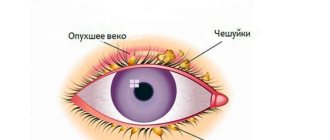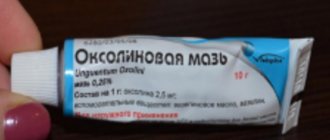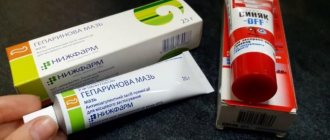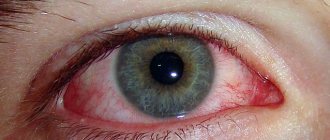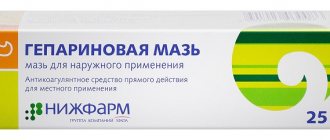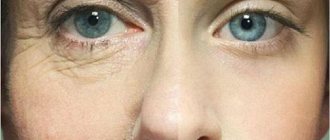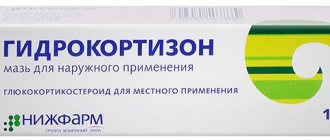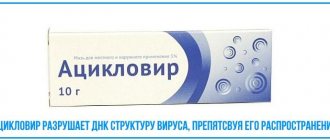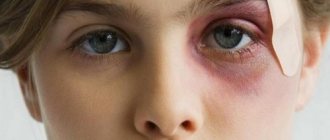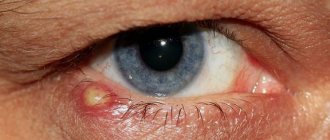Rescue equipment
There may be several reasons why you may feel discomfort in your feet and find that even your usual shoes have become too tight.
- Heredity. Unfortunately, such physiological characteristics can be transmitted genetically, and both men and women are equally susceptible to this.
- Such problems may indicate diseases of the cardiovascular system, thyroid gland and kidneys.
- Excess weight, due to its load on the legs, can also cause swelling.
- The problem often occurs during pregnancy.
And no one is safe from bruises, blows, pinching or even sprains. In such situations, it is important to choose the right ointment, which will help remove not only external manifestations, but also relieve pain.
Operating principle
The effect of gels and similar medications is based on reducing inflammation at the site of swelling. They also have absorbable properties, penetrating deep into tissues and accelerating the process of cell regeneration.
Doctors recommend that, first of all, to treat hematomas from bruises, use the product in the form of a gel, since it is the one that can penetrate into the deeper layers of the skin, and after it you can use creams and warming ointments.
If you don't have any medications on hand, you can use cold compresses or foot baths with cool water. They will narrow the blood vessels and remove discomfort.
What to apply?
Let's move from theory to practice and consider the best drugs to help cope with edema.
- Heparin ointment. You can use this inexpensive remedy in case of injuries, the initial stage of varicose veins and in situations with very tired legs.
It contains benzocaine (which can relieve pain) and sodium heparin (which has a resolving effect). Depending on the scale of the problem, you need to rub in the ointment 1 to 3 times a day, applying the product in a thin layer.
Lyoton-gel and Trombless-gel have the same effect, the main active ingredient in which is also sodium heparin.
- Cream “Mom comfort”. A real lifesaver for those whose work requires constant movement. At the end of the day, tired legs will be saved by the innovative formula of the balm, which will relieve pain, as well as strengthen the walls of blood vessels and improve blood circulation in the extremities. By the way, the cream is produced in Russia.
- Troxevasin. It has a venotonic effect, eliminates pain and has a pleasant cooling effect.
- Essaven gel. Strengthens the capillaries of the legs, tones the veins, stimulates blood microcirculation and relieves inflammation. Effectively removes pain, and when applied to the skin does not leave sticky marks.
Heparin ointment for swelling
In some cases, only drugs related to anticoagulants that have a direct effect can cope with edema. The most effective remedy, the action of which is aimed specifically at eliminating edema, is heparin ointment.
Heparin ointment is prescribed by doctors in various cases:
- when swelling occurs;
- for limb injuries;
- in the presence of hemorrhoids (external);
- at the initial stage of varicose veins and thrombophlebitis;
- for hematomas and inflammation of the lymph nodes, etc.
Heparin ointment contains various substances that have anti-inflammatory, anti-edema and anti-thrombic effects on problem areas of the body:
- benzocaine (relieves pain);
- sodium heparin (prevents the formation of blood clots, and if they are present, promotes resorption);
- benzyl nicotinate (dilates blood vessels).
When swelling occurs, heparin ointment must be applied to the surface of the skin (in problem areas) in a thin layer. Carefully, using light rotational movements, rub the medicine into the skin. Depending on the size of the edema, the ointment is used 2 to 3 times a day, for 1-2 weeks. If the swelling has formed due to mechanical impact (from a fall or impact), the ointment should be started to be used only after a day, in order to avoid the development of internal bleeding.
Before starting treatment for edema, it is better to consult a doctor who will determine its origin and recommend a dosage. This must be done, since heparin ointment has a number of contraindications, which you need to familiarize yourself with before starting the treatment course. If a patient is treating edema with heparin ointment for a long time, he needs to regularly undergo a blood test for coagulation.
Patients may experience various side effects:
- allergic reactions;
- hyperemia;
- thrombocytopenia;
- poor blood clotting, etc.
Pregnant and lactating women should use heparin ointment very carefully. During this period, patients should be under the supervision of their attending physician, who will discontinue this drug at the first alarming symptoms.
Means allowed during pregnancy
Stagnation of fluid in the body often causes edema during pregnancy. In addition, the load on the legs, especially in recent months, becomes quite strong, which affects their condition.
But in this situation, not all products are allowed for women, so before buying an ointment or gel, you should consult a doctor. Among those whose instructions do not contain information about the negative impact on the woman and the fetus are:
- Troxevasin. It comes in gel and capsule form. They have a calming effect and, thanks to the active substance - troxerutin, strengthen the walls of capillaries and blood vessels, accelerate the outflow of blood. They can be used for edema of various origins: during pregnancy, after injuries, for venous insufficiency and thrombophlebitis.
- Venitan. Relieves swelling and helps remove post-traumatic hematomas. It is based on horse chestnut extract, which is a natural remedy that almost never causes allergic reactions. It is a good addition to compression therapy.
- Lyoton 1000. The active ingredient is already known sodium heparin. Effectively removes swelling in a short period, improving blood circulation. May cause allergies, so consultation with a doctor is required.
Medicines will help you quickly cope with tired legs, relieve pain, relieve inflammation and bruises on the body, but if the condition does not improve within a few days of use, you should consult a doctor.
Ointment for bruises and swelling
Local anti-edema agents are recommended for use when indicated. Medicines are prescribed for the following pathological conditions and diseases:
- pain, swelling in the ankles;
- feeling of heaviness, fatigue in the legs;
- blood circulation disorders of an acute or chronic nature;
- muscle spasms at night;
- heavy, prolonged physical activity;
- traumatic injuries;
- presence of bruises;
- formation of post-injection infiltrates.
Some popular effective anti-edema medications are available in gel form. This dosage form differs from an ointment in that it has a water rather than a fatty base. Gels are absorbed faster, adhere well to the skin, do not clog pores, and are easily washed off.
- Actovegin - why it is prescribed to adults and children
- How to put cans on your back
- Lyapko applicator - instructions for use. Where to buy, types and contraindications of the Lyapko needle applicator
On the face
Remedies for swelling on the face should be selected in consultation with a doctor. The following drugs are often prescribed:
| Drug name | Action | Mode of application | Contraindications | Side effects | Price (in rubles) |
| Arnica |
| It is recommended to apply the ointment in a thin layer to the skin in the area of swelling. Frequency of use – 2 times/day. The course of treatment is up to 1 week. | Among the contraindications are:
| Arnica rarely causes side effects such as allergic reactions. | 60-70 |
| Sinyakoff |
| The ointment must be applied with gentle rubbing movements to the site of injury 1-2 times a day. It is allowed to use the drug to relieve swelling and inflammation for no more than 5 days. | There is increased sensitivity to the components and impaired blood clotting. | The gel has no side effects. | 120-140 |
On foot
Excessive fluid accumulation in the lower extremities is a consequence of vascular problems, injuries, and joint inflammation. The following local medications are recommended for swelling in the legs:
| Drug name | Action | Mode of application | Contraindications | Side effects | Price (in rubles) |
| Lyoton 1000 | Ointment for swelling of the legs based on sodium heparin. The medicine has a moderate anti-inflammatory effect, reduces blood clotting, the permeability of vessel walls, and prevents the spread of fluid into adjacent tissues. | A strip of ointment 3-10 cm long is applied with light rubbing movements 1-3 times a day. The duration of treatment depends on the severity of the course and the severity of the pathology. |
| The gel may cause allergic reactions. | 500-600 |
| Troxevasin | The ointment has a venoprotective, venotonic, anti-inflammatory effect, and reduces swelling. | The medication is intended for local use. It is recommended to apply the gel 2 times a day to the affected areas. The product must be rubbed in until completely absorbed. The course of therapy is up to 1 week. |
| In rare cases, Troxevasin can cause allergic reactions such as itching, urticaria, dermatitis, and eczema. | 400-450 |
During pregnancy
While carrying a child, it is necessary to select ointments that do not harm the health of the fetus. The following decongestants are often prescribed:
| Drug name | Action | Mode of application | Contraindications | Side effects | Price (in rubles) |
| Troxerutin | The gel helps improve vascular tone, reduces their fragility and permeability, eliminates inflammation, and is used for varicose veins. | During pregnancy, the gel can be used from the 2nd trimester. You need to apply the product 3-4 cm 1-2 times a day. The gel must be distributed evenly and rubbed into the skin until completely absorbed. | Among the contraindications are:
| A side effect of use may be an allergic rash. | 250-300 |
| Venitan | The product has anti-inflammatory and venotonic properties, relieves swelling, improves the density of vascular walls. | The gel is applied to the affected area in a thin layer, gently rubbing. Frequency of application – 2-3 times/day. Course – 1 week. | A contraindication to the use of Venitan is hypersensitivity to the components of the medication. | Allergic reactions are possible. | 200-250 |
For the elderly
Swelling of various parts of the body is often observed in older people. The following local medications are recommended for elderly patients:
| Drug name | Action | Mode of application | Contraindications | Side effects | Price (in rubles) |
| Rescuer | The balm has a natural base and has anti-inflammatory and analgesic properties. | The ointment is applied 1-2 times/day with massage movements to the affected area. The course depends on the severity of the symptoms. |
| Not detected. | 150-160 |
| Heparin ointment | The drug is a direct anticoagulant, has an anti-inflammatory, local anesthetic effect, and prevents the formation of blood clots. | The product should be applied to swollen areas 3 times a day. The course of therapy is up to 2 weeks. | It is prohibited to use heparin ointment for open skin lesions, hypocoagulation, thrombocytopenia, or hypersensitivity to the composition. | With long-term therapy, allergic reactions are possible. | 40-70 |

